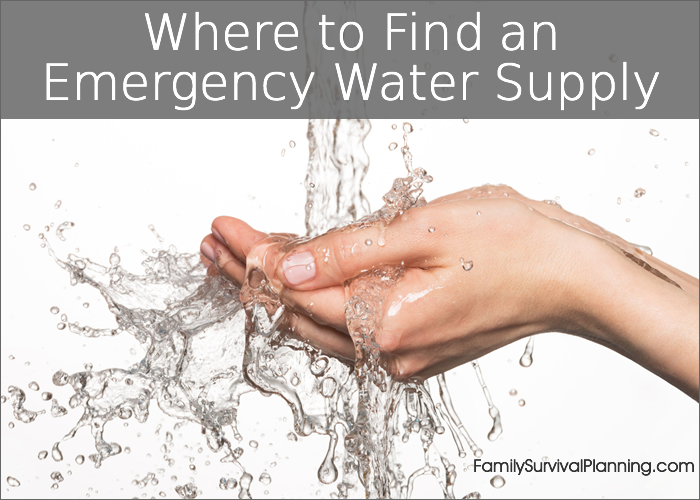- HOME
- Water Storage Basics
- Emergency Water Supply
Where to Find an
Emergency Water Supply

The most frequently asked questions about water storage are:
- How do you purify water for storage?
- Where am I going to store it? It takes up a lot of space and it's heavy.
- How much IS enough?
Invest in emergency food storage now and enjoy peace of mind for the next 25 years. Don't miss out on the savings!
A person can survive without food for several weeks, but can only survive without water for a few days.
So think about this . . .
How much water do we waste in a day?
While preparing dinner, do we leave the water running in the sink while scrubbing the potatoes? Then we pour out the excess water after boiling them, and leave the water running while we wash out the pan. Water lost? About 10 gallons (not a scientific calculation - just a guess).
How much water is wasted when we take showers?
We are a spoiled society. We are used to having water fit to drink, bathe in, and cook with, just come out of the tap when we turn it on. A natural disaster could easily disrupt that, like an earthquake that breaks main water pipes.
If or when a disaster happens, we should consider all water contaminated whether it comes from your home pipes, a cistern, a well or otherwise. (See water supplies after a nuclear attack.)
Did you know that the water in your home pipes is dependent on electricity? No electricity - no water being pumped into your home.
Take away lesson: Catch and store any water you can and use it for "gray" water, like for flushing toilets, if it's not purified. Don't forget to label it "DO NOT DRINK".
Since most of us don't live by a stream or have our own well, we must find a way to save ALL kinds of water and store it for emergencies. But be aware that there are water storage myths out there in "cyber world" that stop many from storing water in certain containers as well as methods of storage that may seem like too much trouble. Read the myths and don't let them stop you - water is #1 in importance for survival.
How much is enough?
FEMA and other emergency services recommend that we have at least a two-week emergency water supply on hand at all times. Bare-bones survival rations would be 1/2 gallon per person per day just for drinking and minimal food preparation purposes. You might not think that you drink that much in a day, but I'll bet if you added up all the water, juice, milk, soft drinks, broth, and other liquids, you would be close to consuming 1/2 gallon. In an emergency, you may find that you want more liquid than in regular circumstances.
In addition to drinking water, you will need 1/2 gallon per person per day for other uses, such as brushing teeth, washing dishes, etc. So 1 gallon per person per day is the bare minimum. On a regular day, you may wash several gallons of water down the drain as you rinse the dinner dishes. In an emergency situation, you will have to keep a watchful eye on the amount used for those purposes. A wet cloth wipe-up may be all your dishes get.
To determine more accurately how much water your family needs, ask yourself these questions:
- Do you have a baby in your house? How much water do you need for preparing formula or baby food? Since babies sometimes spit up and make messes, you'll need sufficient water to clean up.
- Active teenagers usually drink more liquids than adults. Make sure to store plenty of water for active teens.
- Is any member of your family an invalid or chronically ill? Do they have an increased need for water to take medications or for personal care?
- Do you have pets? If so, you'll need to plan additional water for them.
- If the majority of your storage foods are dry or dehydrated, you'll need more water for preparation of those foods.
- Do you live in an area where extreme heat is a regular occurrence? Everyone will need more water if that is your situation.
- Are you accustomed to drinking more water for good health? If so, cutting back drastically, especially in a time of crisis, could be very difficult physically.
Where is there already water in your home?
If an earthquake or other catastrophe happened right now, before you've had a chance to acquire your emergency water supply, where could you find some?
The hot-water heater is the first place to go. There is clean, drinkable water there. Depending on the size of your water heater, there should be 20-50 gallons. The trick is to get it out. Have a bucket handy and put it under the drain faucet. (Make sure it's not still hot!) Then open a water faucet in a sink nearby to release the pressure and cause the water to flow.
In order to use this water for drinking, here are a few steps you need to follow:
Step 1: Shut off the valve that leads from your main water line to the hot water heater immediately after the emergency to prevent the water from becoming contaminated.
Step 2: Disconnect the water heater’s power supply (either electric or gas)
Step 3: Allow the water inside the heater to cool before you attempt to drain any water from it. This could take several hours.
Step 4: Disconnect the hot water line at the top of the tank. If you can’t get the line off, turn on the hot water faucet closest to the tank in order to relieve pressure.
Step 5: Open the drain valve at the bottom of the tank and collect the water in a clean storage container. Over time, rust and corrosion will build up and settle at the bottom of the tank. If the water does not look clean, discard it until clean water begins to drain.
Step 6: While this water should be safe to drink, it is still recommended that you treat the water by adding six drops of liquid household bleach for every gallon of water. Allow the water stand for 30 minutes. The water should now be completely safe.
Warning: Turn off the power supply to the tank first. Even if there is a power failure, you must unplug, turn off the circuit breaker, or close the gas valve first. Leaving the heating part on while the water heater is empty could cause an explosion or burn out the elements, destroying your water heater. Don't turn on the water heater again until water services have been restored and the water heater is refilled.
There is also water in your pipes that can be used. Open a water faucet in the highest part of the house and then drain the pipes from the lowest faucet in the house. If you know the electricity is going to be off for a while, you can empty the water in your pipes into the bath tub for using later. If you have a Water BOB (or other brand), use it in the tub and it will keep the water safe and clean for drinking.
If the emergency is an earthquake or an landslide, you may have to turn off your water from outside the house to avoid contamination to the water inside your water heater and pipes.
Then there is the toilet tank (not the bowl). There is about 3 to 5 gallons of clean water in each tank. You can dip it out with a cup or ladle. If you are a little squeamish about drinking water from the toilet tank, use that water for your pet or for cleanliness.
Don't forget the liquids in most canned goods. Canned fruit, vegetables or broth have liquid that can be used to cook with or to drink if absolutely necessary.
A swimming pool or hot tub is a good source of emergency water supply. Can it be used for drinking? The short answer is maybe. The long answer is that it depends on how many chemicals have been added to the pool water. If it is your own pool, then you know what chemicals are in the water and its general condition. If it is someone else's, you many not know the condition of the water.
Remember, if there is a crisis where the power is out, the pool filter will not be working. It will take about a week for algae to begin growing as well as other bacteria. While you could still filter the water for drinking, it would be safer if you could test the water, even after filtering. A good water filter, such as the Katadyn Vario Dual Microfilter, states that it will filter out chemicals, pesticides, and a whole list of bad bacteria.
If you don't feel safe drinking pool water, use it for "gray" water after filtering - for washing clothes, flushing toilets, even bathing.
Make a list of all the available sources for your emergency water supply. Keep it handy with all your other emergency supply lists.











